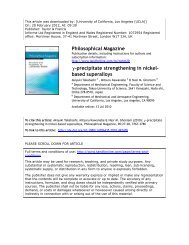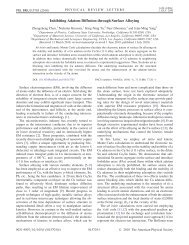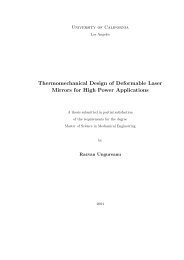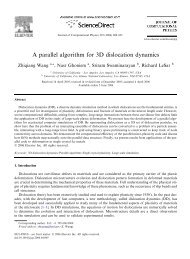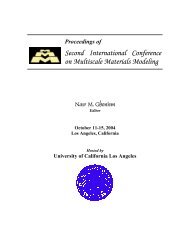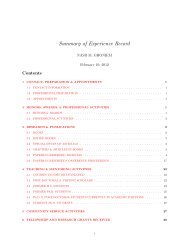FS&T Template - Nasr Ghoniem's Matrix Laboratory - UCLA
FS&T Template - Nasr Ghoniem's Matrix Laboratory - UCLA
FS&T Template - Nasr Ghoniem's Matrix Laboratory - UCLA
You also want an ePaper? Increase the reach of your titles
YUMPU automatically turns print PDFs into web optimized ePapers that Google loves.
We presented here the design, the thermo-mechanical<br />
analysis, and the prototype fabrication status of a SiCfoam<br />
based FCI structure.<br />
The flow channels for PbLi in the ITER DCLL TBM<br />
design are about 1.6 m high. Allowing for supply and<br />
return space at the bottom and the top of the channel a<br />
straight FCI structure of 1.3 m is required. The 1.3 m tall<br />
FCI structure was divided into five 0.25 m tall segments,<br />
which are assembled using CVD-SiC brackets. Two<br />
analyses were performed, one with uniform through the<br />
thickness temperature gradients of 40 o C and one with<br />
established ITER relevant non-uniform temperature<br />
gradients.<br />
The porous FCI design is based on a 3-mm thick SiCfoam<br />
core between two 1-mm thick CVD SiC face sheets.<br />
The current design uses brackets to assemble five 25-cm<br />
tall FCI segments. Thermo-structural analysis of a single<br />
section with a uniform temperature gradient shows that<br />
the thermal resistance between the brackets and the FCI<br />
panels would have to be minimized in order to reduce<br />
thermal stresses in the FCI panels to acceptable levels.<br />
A thermo-mechanical analysis of the full-length FCI<br />
structure, 1.3 m long including the hydrostatic pressure<br />
head of PbLi was also performed. Detailed FCI-breeder<br />
interface temperature distributions based on 3-D<br />
magnetohydrodynamic calculations representative of<br />
ITER operations were using and mapped as thermal<br />
boundary conditions onto the full-length FCI walls.<br />
Maximum temperatures (~430<br />
o C) and temperature<br />
gradients (~40 o C) were found to be highly localized in<br />
the top region (exit) of the FCI structure. Calculated von<br />
Mises stresses were shown to be relatively evenly<br />
distributed over the entire FCI structure, ranging between<br />
20 and 50 MPa. Maximum stresses (~66 MPa) were<br />
shown to occur on the FCI panel underneath a bracket<br />
near the mid plane of the FCI structure. The preliminary<br />
analysis of a SiC-foam based FCI indicates that this<br />
concept satisfies key design requirements for ITER<br />
operation.<br />
Ultramet Inc. is fabricating a prototype of the SiCfoam<br />
based FCI consisting of a 5-mm SiC-foam core with<br />
1.8-mm thick CVD SiC face sheets. The FCI segment<br />
under construction is 116 cm×116 cm×300 cm tall. 8<br />
ACKNOWLEDGMENTS<br />
This work was supported by the US. Department<br />
of Energy, Office of Fusion Energy Sciences through an<br />
SBIR Phase-II Grant to Ultramet Inc.<br />
REFERENCES<br />
Sharafat et al.<br />
1. C.P.C. Wong, S. Malang, M. Sawan, M. Dagher, S.<br />
Smolentsev, B. Merrill, M. Youssef, S. Reyes, D.K.<br />
SiC-FOAM BASED FLOW CHANNEL INSERT FOR DCLL TBM<br />
Sze, N.B. Morley, S. Sharafat, P. Calderoni, G.<br />
Sviatoslavsky, R. Kurtz, P. Fogarty, S. Zinkle, M.<br />
Abdou, An overview of dual coolant Pb17Li breeder<br />
first wall and blanket concept development for the US<br />
ITER-TBM design, Fusion Engineering and Design 81<br />
(2006) 461467.<br />
2. P. Norajitra, L. Bühler, U. Fischer, K. Kleefeldt, S.<br />
Malang, G. Reimann, H. Schnauder, L. Giancarli, H.<br />
Golfier, Y. Poitevin, J.F. Salavy, The EU advanced<br />
lead lithium blanket concept using SiC f /SiC flow<br />
channel inserts as electrical and thermal insulators,<br />
Fusion Engineering and Design 5859 (2001) 629<br />
634.<br />
3. F. Nadjmabadi and The ARIES Team, Overview of<br />
the ARIES-RS reversed-shear tokamak power plant<br />
study, Fusion Engineering and Design 38 (1997) 325.<br />
4. B.A. Pint, J.L. Moser, P.F. Tortorelli, Investigation of<br />
PbLi compatibility issues for the dual coolant blanket<br />
concept, Journal of Nuclear Materials 367370 (2007)<br />
11501154.<br />
5. S. Smolentsev, M. Abdou, N.B. Morley, M. Sawan, S.<br />
Malang, C. Wong, Numerical analysis of MHD flow<br />
and heat transfer in a poloidal channel of the DCLL<br />
blanket with a SiCf/SiC flow channel insert, Fusion<br />
Engineering and Design 81 (2006) 549553.<br />
6. C.P.C. Wong, V. Chernov, A. Kimura, Y. Katoh, N.<br />
Morley, T. Muroga, K.W. Song, Y.C. Wu, M. Zmitko,<br />
ITER-Test blanket module functional materials,<br />
Journal of Nuclear Materials 367370 (2007) 1287<br />
1292.<br />
7. A.A. Wereszczak, E. Liu, V. Heng, T.P. Kirkland and<br />
M.K. Ferber, The high temperature compressive<br />
strength of non-oxide ceramic foams, Materials<br />
Science and Engineering A, Volume 219, Issues 1-2,<br />
30 November 1996, 224-228.<br />
8. Ultramet Inc., Pacoima, CA 91221, USA;<br />
http://www.ultramet.com/, accessed Dec. 2008.<br />
9. G. E. Youngblood, R. J. Kurtz, and R. H. Jones,<br />
SIC/SIC DESIGN FOR A FLOW CHANNEL<br />
INSERT, Semi-Annual Progress Report, 2004,<br />
Volume 37, 3-8.<br />
10. G. E. Youngblood, D. J. Senor and R. H. Jones,<br />
Effects of irradiation and post-irradiation annealing on<br />
the thermal conductivity/diffusivity of monolithic SiC<br />
and f-SiC/SiC composites, J. Nucl. Mater. 329-333<br />
(2004) 507-512.<br />
11. B. Williams, Ultramet Internal Technical Memo, Feb.<br />
2007, Ultramet Inc., Pacoima, CA 91221, USA.<br />
12. Y. Katoh, Oak Ridge National <strong>Laboratory</strong>, ORNL TN,<br />
private communications, May 2006.<br />
13. S. Smolentsev, et al., Characterization of key<br />
magnetohydrodynamic phenomena in PbLi flows for<br />
the US DCLL blanket, Fusion Eng. Des. (2008),<br />
doi:10.1016/j.fusengdes.2008.07.023<br />
FUSION SCIENCE AND TECHNOLOGY VOL. 56 AUG. 2009 891



